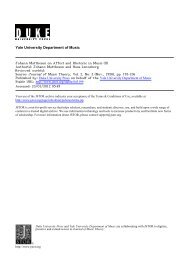Après une Lecture de Liszt: Virtuosity and ... - Free
Après une Lecture de Liszt: Virtuosity and ... - Free
Après une Lecture de Liszt: Virtuosity and ... - Free
You also want an ePaper? Increase the reach of your titles
YUMPU automatically turns print PDFs into web optimized ePapers that Google loves.
19THCENTURYMUSICcompositions without having the music before him,” Masonrecalls, “<strong>and</strong> during most of the time I was [in Weimar]copies of his later publications were always lying on thepiano, <strong>and</strong> among them a copy of the ‘Bénédiction <strong>de</strong> Dieudans la Solitu<strong>de</strong>,’ which <strong>Liszt</strong> had used so many timeswhen playing to his guests that it became associated withmemories of Berlioz, Rubinstein, Vieuxtemps, Wieniawski,Joachim, <strong>and</strong> our immediate circle” (William Mason,Memories of a Musical Life [New York: Century, 1901], p.118).111Rosen, Romantic Generation, p. 507.even remaining cautious, we can confirm that<strong>Liszt</strong> performed at least three partially unwritten“works” during the 1840s, that his sketcheswere roughly coeval with their improvisation/performance, <strong>and</strong> that their performance prece<strong>de</strong>dtheir final “composition,” or rather, thatat this stage in <strong>Liszt</strong>’s life, performance <strong>and</strong>composition were effectively synonymous processeswithin the economy of his creative production.This condition un<strong>de</strong>rmines the unqualifiedaspiration of Werktreue in performance by invertingconventional i<strong>de</strong>as about what it is thatis inscribed by a classical score. For <strong>Liszt</strong>’s earlywork on the “Dante” Sonata, notation seemsto function, not as the basis for future performance,but at least in part as the recordingmedium of past performance. This status ismost apparent in plate 2, written as a mementofor an admirer ex post facto. The changes betweenthis manuscript <strong>and</strong> ex. 6 are suggestiveof the consi<strong>de</strong>rable distance traversed betweenimprovisatory performance <strong>and</strong> final notation.We may therefore think of the successive revisionsas “virtual” performances that inscribehypothetical (or perhaps real) improvisationsthat may or may not have originated in concert.Rosen may have been thinking along theselines when he stated that <strong>Liszt</strong>’s music wasconceived absolutely for performance <strong>and</strong> thatits “realization . . . took prece<strong>de</strong>nce over theun<strong>de</strong>rlying compositional structure.” 111 In thisrepertoire, a performer ascends in the normativemusical hierarchy, assuming aspects ofwhat conceptually is a compositional prerogative:to prescribe the notes <strong>and</strong> their or<strong>de</strong>r.This late-twentieth-century viewpoint reflectsa performance-centered aesthetic that mayadd another facet to our assessment of certainof <strong>Liszt</strong>’s pre-Weimar piano works. Seen originallyas transcriptions or amalgams of performanceevents in which the composer <strong>and</strong> performerare one, these “compositions” may beginto assume a new <strong>and</strong> perhaps unfamiliarintegrity. For rather than measuring themagainst the “covert i<strong>de</strong>ological agenda,” 112 asSamson has called it, of the German sonatasymphonictradition, we can view them as productsof a different i<strong>de</strong>ology: that of the improviser-virtuoso.This revisionist perspective resonatessuggestively with an early-nineteenthcenturysentiment perhaps most eloquently—if hyperbolically—formulated in the mid-1840sby an anonymous Darmstadt correspon<strong>de</strong>ntwho dispelled any ambivalence about <strong>Liszt</strong>’sWerktreue <strong>and</strong> his stature as a composer byexplicitly construing performance <strong>and</strong> compositionas synonymous acts in the mind of thegenius:His performance is never a mechanical utterance[Vonsichgeben], rather a composition in the truestsense of the word, an artistic creation existing entirelyfor itself, reborn through fire <strong>and</strong> passion fromwithin. In general he regards every piece he plays asa theme on which to improvise <strong>and</strong> almost alwayscreates anew something won<strong>de</strong>rful, in doing so [he]simultaneously <strong>de</strong>clares the aspiration of the truegenius: always to loosen his art more from all formal<strong>and</strong> frightening shackles, <strong>and</strong> with true enthusiasm<strong>and</strong> unconstrained by all external rules, to reproducein a carefree manner what his inner eye has intuited.113112Samson, <strong>Virtuosity</strong> <strong>and</strong> the Musical Work, p. 112.113“Sein Vortrag ist niemals ein mechanisches Vonsichgeben,son<strong>de</strong>rn im eigentlichsten Sinne <strong>de</strong>s Wortes eineComposition, eine ganz für sich bestehen<strong>de</strong> Schöpfung <strong>de</strong>rKunst, durch Feuer und Lei<strong>de</strong>nschaft von innen herauswie<strong>de</strong>rgeboren. Je<strong>de</strong>s Stück, das er spielt, betrachtet er imAllgemeinen als ein Thema, über welches er phantasirtund fast immer etwas Wun<strong>de</strong>rvolles neu erschafft, undwobei sich zugleich die wahrhaft geniale Strebung kundgibt:seine Kunst immer mehr von allen formellen undbeängstigen<strong>de</strong>n Fesseln loszumachen und in wirklicherBegeisterung und unbekümmert um allen äußerenRegelzwang, das sorglos nachzubil<strong>de</strong>n, was sein inneresAuge geschaut hat” (“Franz <strong>Liszt</strong> [in Darmstadt]” [6 Oct.1845], 1499. This is contained in a small collection ofthus-far uni<strong>de</strong>ntifiable German press articles about <strong>Liszt</strong>between 1838 <strong>and</strong> 1847, which are held in the Nationalarchiv<strong>de</strong>r Richard-Wagner-Stiftung in Bayreuth as: II C b3.Hummel’s comments on the prestige of improvisationalign him with this view <strong>and</strong> offer a complementary perspectiveto the listener-based quotation above. In the final90



